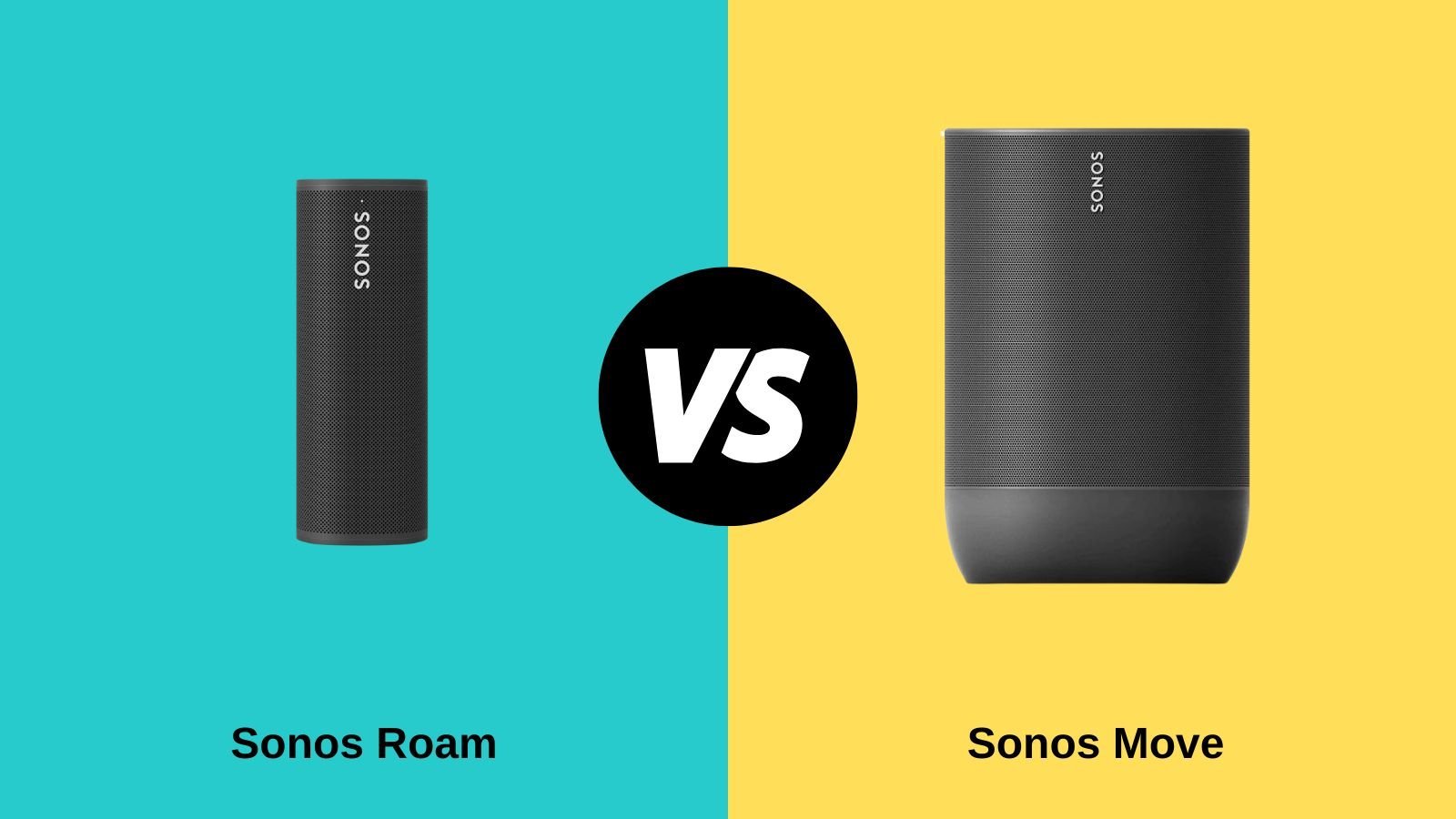
Sonos Rome and Sonos Move. So, today, we’re going to compare the Sonos Move and Sonos Roam to help you decide which one might be the best option. Suppose you are familiar with Sonos products already. In that case, you will probably know there are some critical differences between these two products, and you might be thinking they’re not comparable, and you would be correct.
Still, if you are unsure or you’re new to Sonos, you might struggle to decide which option is the best option for you.
| Sonos Roam | Sonos Move |
 |  |
| BUY NOW | BUY NOW |
| PROS | PROS |
| + It’s very rugged and water-resistant (IP67). + Much more affordable than the Move. + Super portable, less than 1 pound. | + Better sound. Arguably the best portable speaker you can buy. + Charging cradle is included. |
| CONS | CONS |
| – The wireless charger is sold separately. – Smaller size means it can’t match the Move in sound quality. | – It’s big and heavy, weighing over 6 pounds, so it’s only portable to a point. – It’s expensive. – It’s water-resistant (IP56) but not waterproof. – Requires manually switching between Wi-Fi and Bluetooth. |
Price and Availability
Let’s start by going over the essential information about these two products. These speakers are a little different because they are portable speakers with built-in Wi-fi and Bluetooth. As a result, you can use them to connect to your home’s Sonos ecosystem and then switch to Bluetooth to take your music with you.
With an RRP of $159, the little Sonos Roam, their newest addition to the Sonos lineup, is also the smallest and most affordable speaker in the entire Sonos lineup. The Sonos Move is essentially the bigger brother of the Sonos Rome, and as you can see from side-by-side, it is significantly bigger. It costs $399, making it the most expensive speaker of the two I have here.
These two speakers now support voice control with Amazon or Google Assistant, and if you want a little more privacy, you can completely turn off the power to the microphones.
Sonos Roam vs Sonos Move: Design

Looking at the overall design of the two speakers, it is clear that they are all very different in size and shape. The Rome, for example, is much lighter and smaller, with a more triangular shape akin to a Toblerone that allows it to be stood upright or laid down flat.
The Rome has been designed to be slightly more durable with a rubberized top and bottom. The Move is available in black or luna white, slightly different from the white on the one and more of a pale grey that I personally like.
The Move, however, is much larger and heavier than the Roam; it is also six times bigger. It also has a convenient carry handle on the back and a rubberized base for additional protection in case you drop it and keep it stable on surfaces. If we look at the top panel of both devices, they offer controls on the speaker, touch controls on the Move, and rubberized buttons on the roam.
Sonos Roam vs Sonos Move: Sound Comparison

Okay, now let’s talk about the differences in sound performance. There isn’t a comparison to be made here, and you pay for the difference. According to my review, the Move is 30% better than the Rome. Of course, this is just my opinion, and others may think that percentages are a little higher. However, it does give you a general idea of the difference.
I did have a few ideas, though, about how the sound quality of these two speakers differs. Being the larger speaker, the move produces an extra layer of bass, which essentially makes it easier to listen to in larger spaces.
You can’t expect the Rome to fill a large garden the same way the Move does; instead, it’s best to carry with you on your adventures or listen in those smaller areas. Moving down to the Rome, it still offers a familiar sonar sound signature with those crisp vocals and surprisingly decent bass for its size.
They all, in my opinion, share the same Sonos trademark, which is like a well-balanced audio performance with crisp vocals. They generally do a good job of preserving the details of an audio track.
Sonos Roam vs Sonos Move: Key Features
Now that we can compare and contrast the two portable options, some key characteristics exist. The Roam and the Move are both portable speakers in their own right, but the Roam is more so because of its small size, which allows you to throw it into a backpack without worrying about it too much.
1. Weights

There’s no escaping the fact that the Move is quite a heavy portable speaker; you wouldn’t want to be carrying it on a bike ride, for instance, as it is quite a heavy speaker.
2. Duarbility

The Roam is rated at ip67, whereas the Move is only rated at ip56. This means that the Roam can effectively be submerged in water up to one metre deep for up to 30 minutes without experiencing any damage.
The Roam is more durable and slightly more portable than the Move overall, but the Move is protected from strong jets of water from all sides. So if you’re going to be near a pool or the sea, the Roam would be fine to be dropped in water. If you spill a drink or get caught in a shower, neither will hurt you because both would be fine in the rain.
3. Battery Life & Charging

Both the Move and the Roam have rechargeable batteries; however, the Move offers a battery life of 11 hours compared to the Roam’s 10 hours. Both devices performed better than this in our testing, but the Move’s battery will generally last slightly longer.
Another difference is that while the Roam only comes with a charging cable and no plug, the Move includes a recharging dock that can serve as both a base station and a charger. You can upgrade the Roam’s charging base from Sonos for an additional $44 or use any other compatible wireless Qi charger. Both devices can also be charged via USB-C.
4. Soud Swap

The Roam is the more recent model. It also has a feature called sound swap that is very helpful and that the other speakers don’t have. For example, when you come inside from the garden, press and hold the play pause button and it will send whatever you’re listening to to the closest speaker in that room to continue listening, so it’s a more seamless experience.
5. Trueplay Tuning

Additionally, both speakers have Sonos’s own Trueplay Tuning technology, which uses the microphones in your iOS device to detect the speaker’s surroundings and then optimise the acoustics for that space. The difference between the Roam and Move is that this is automatic, so it will recognise when it has been placed in a new environment and then adjust to that ESO you don’t need to go through a manual tuning process.
Conclusion
So now that we’ve discussed the variations in features and audio quality let’s talk about when these various speakers would be helpful and which situations we would recommend them for.
The Move would be my recommendation if you want a speaker to take you from room to room, into the garden, and a more immersive sound experience. It comes with a charging dock, so it will become part of that home ecosystem without ever needing to be removed. I would also recommend that you want a speaker to take you from room to room, into the garden, and have a more immersive sound experience.
The Rome is the speaker for you if you’re looking for a truly portable device that you can throw in a bag, take with you wherever you go, and use in your home, bathroom, etc.




